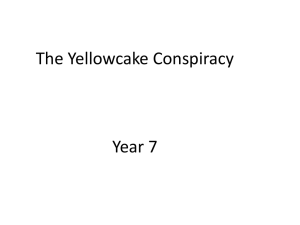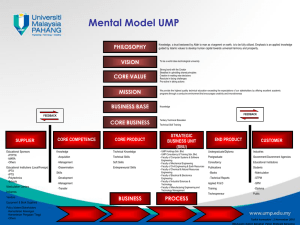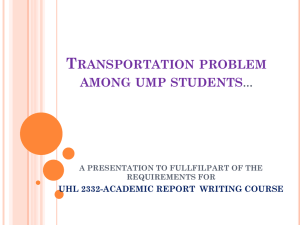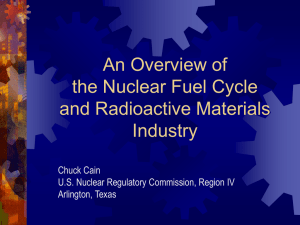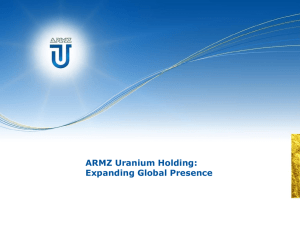Lecture 1: RDCH 710 Introduction
advertisement
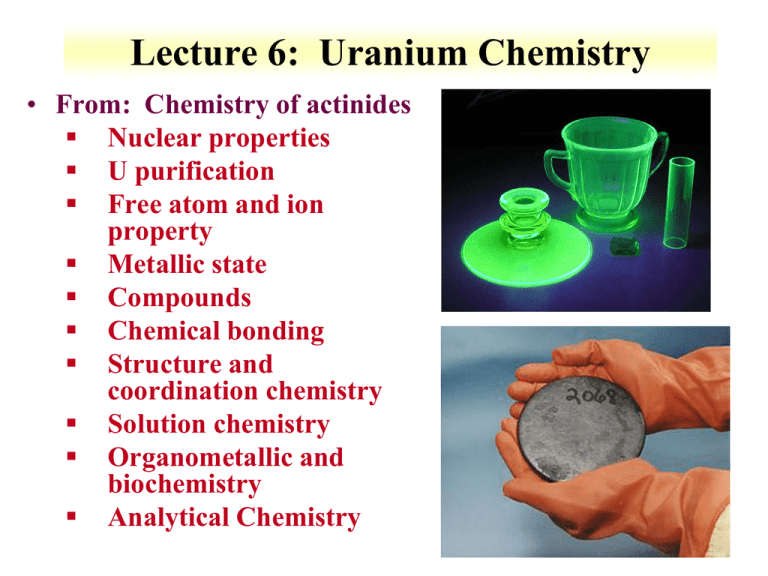
Lecture 6: Uranium Chemistry • From: Chemistry of actinides Nuclear properties U purification Free atom and ion property Metallic state Compounds Chemical bonding Structure and coordination chemistry Solution chemistry Organometallic and biochemistry Analytical Chemistry 6-1 Nuclear properties • Fission properties of uranium Defined importance of element and future investigations Identified by Hahn in 1937 200 MeV/fission 2.5 neutrons • Natural isotopes 234,235,238U Ratios of isotopes established 234: 0.005±0.001 235: 0.720±0.001 238: 99.275±0.002 • 233U from 232Th 6-2 Uranium Minerals • • 200 minerals contain uranium Bulk are U(VI) minerals U(IV) as oxides, phosphates, silicates Classification based on polymerization of coordination polyhedra Mineral deposits based on major anion Secondary phases may be important for waste forms Incorporation of higher actinides Pyrochlore A1-2B2O6X0-1 A=Na, Ca, Mn, Fe2+, Sr,Sb, Cs, Ba, Ln, Bi, Th, U B= Ti, Nb, Ta U(V) may be present when synthesized under reducing conditions * XANES spectroscopy * Goes to B site 6-3 Polyhedra classification U(VI) minerals • • • Linkage over equatorial position Bipyramidal polyhedra Oxygens on uranyl forms peaks on pyramid Different bond lengths for axial and equatorial O coordinated to U Method for classification Remove anions not bound by 2 cations, not equatorial anion on bipyramid Associated cation removed Connect anions to form polyhedra Defines anion topology Chains defined by shapes P (pentagons), R (rhombs), H (hexagons), U (up arrowhead chain), D (down arrowhead chain) 6-4 Uranium purification from ores • Common steps Preconcentration of ore • Based on density of ore Leaching to extract uranium into aqueous phase Calcination prior to leaching * Removal of carbonaceous or sulfur compounds * Destruction of hydrated species (clay minerals) Removal or uranium from aqueous phase Ion exchange Solvent extraction Precipitation Leaching with acid or alkaline solutions Acid solution methods Addition of acid provides best results * Sulfuric or HCl (pH 1.5) U(VI) soluble in sulfuric Oxidizing conditions may be needed MnO2 , chlorate, O2, chlorine Generated in situ by bacteria High pressure oxidation of sulfur, sulfides, and Fe(II) * sulfuric acid and Fe(III) Carbonate leaching Formation of soluble anionic carbonate species Somewhat specific for uranium Use of O2 as oxidant Bicarbonate prevents precipitation 6-5 of Na2U2O7 * OH-+HCO3-CO32- + H2O Recovery of uranium from solutions • • • • Ion exchange U(VI) anions in sulfate and carbonate solution UO2(CO3)34 UO2(SO4)34 Load onto anion exchange, elute with acid or NaCl Solvent extraction Continuous process Not well suited for carbonate solutions Extraction with alkyl phosphoric acid, secondary and tertiary alkylamines Chemistry similar to ion exchange conditions Chemical precipitation Older method Addition of base Peroxide * Ultimate formation of (NH4)2U2O7 (ammonium diuranate), then heating to form U3O8 or UO3 • TBP extraction Contaminates depend upon mineral Based on formation of nitrate species V, Mo UO2(NO3)x2-x + (2-x)NO3- + 2TBP UO2(NO3)2(TBP)2 6-6 Uranium atomic properties • Ground state electron configuration [Rn]5f36d17s2 • Term symbol 5L6 6-7 cm-1 6-8 6-9 Metallic Uranium • Three different phase a, b, g phases Dominate at different temperatures • Uranium is strongly electropositive Cannot be prepared through H2 reduction • Metallic uranium preparation UF4 or UCl4 with Ca or Mg UO2 with Ca Electrodeposition from molten salt baths 6-10 Metallic Uranium phases a-phase Room temperature to 942 K Orthorhombic U-U distance 2.80 Å Unique structure type b-phase Exists between 668 and 775 ºC a‐phase U-U distances in layer Tetragonal unit cell (2.80±0.05) Å and between layers g-phase 3.26 Å Formed above 775 ºC bcc structure • Metal has plastic character Gamma phase soft, difficult fabrication Beta phase brittle and hard • Paramagnetic • Temperature dependence of resistivity b-phase 6-11 Resistivity–temperature curve for a-U along the [010] axis 6-12 Intermetallic compounds • Wide range of intermetallic compounds and solid solutions in alpha and beta uranium Hard and brittle transition metal compounds U6X, X=Mn, Fe, Co, Ni Noble metal compounds Ru, Rh, Pd * Of interests for reprocessing Solid solutions with: Mo, Ti, Zr, Nb, and Pu 6-13 Uranium-Titanium Phase Diagram. Uranium-Aluminum Phase Diagram. 6-14 Chemical properties of uranium metal and alloys • Reacts with most elements on periodic table Corrosion by O2, air, water vapor, CO, CO2 • Dissolves in HCl Also forms hydrated UO2 during dissolution • Non-oxidizing acid results in slow dissolution Sulfuric, phosphoric, HF • Exothermic reaction with powered U metal and nitric • Dissolves in base with addition of peroxide peroxyuranates 6-15 Uranium compounds • Uranium-hydrogen b-UH3 from H2 at 250 ºC a-UH3 prepared at 80 ºC from H2 at 250 6-16 Uranium hydride compounds • Uranium borohydride • UF4 + 2Al(BH4)3U(BH4)4 + 2Al(BH4)F2 U(BH)4 is tetragonal U(BH4)3 forms during U(BH4)4 synthesis Vapor pressure log p (mmHg) =13.354-4265T1 • UXAlHy compounds UXAl absorbs hydrogen upon heating X=Ni, Co, Mn y = 2.5 to 2.74 TGA analysis evaluates hydrogenation 6-17 Uranium-oxygen • UO Solid UO unstable, NaCl structure From UO2 heated with U metal Carbon promotes reaction, formation of UC • UO2 Reduction of UO3 or U3O8 with H2 from 800 ºC to 1100 ºC CO, C, CH4, or C2H5OH can be used as reductants O2 presence responsible for UO2+x formation Large scale preparation UO4, (NH4)2U2O7, or (NH4)4UO2(CO3)3 Calcination in air at 400-500 ºC H2 at 650-800 ºC UO2has high surface area 6-18 Uranium-oxygen • • • U4O9 UO2 and U3O8 5 UO2+ U3O8 2 U4O9 Placed in evacuated ampoule Heated to 1000 ºC for 2 weeks * Three phases a-U4O9 up to 350 K b-U4O9 350 K to 850 K g-U4O9 above 850 K Rearrangement of U4+ and U5+ forces disordering of O U3O7 Prepared by oxidizing UO2 below 160 ºC 30 % of the oxygens change locations to new positions during oxidation Three phases b phase prepared by heating at 200 ºC U2O5 High pressure synthesis, three phases a-phase UO2 and U3O8 at 30 kbar and 400 ºC for 8 hours Also prepared at 15 kbar and 500 ºC b-phase forms at 40-50 kbar above 800 ºC g-phase sometimes prepared above 800 ºC at 60 kbar 6-19 Uranium-oxygen • U3O8 From oxidation of UO2 in air at 800 ºC a phase uranium coordinated to oxygen in pentagonal bipyrimid b phase results from the heating of the a phase above 1350 ºC Slow cooling 6-20 Uranium-oxygen • UO3 Seven phases can be prepared • A phase (amorphous) Heating in air at 400 ºC * UO4.2H2O, UO2C2O4.3H2O, or (HN4)4UO2(CO3)3 Prefer to use compounds without N or C a-phase Crystallization of A-phase at 485 ºC at 4 days O-U-O-U-O chain with U surrounded by 6 O in a plane to the chain Contains UO22+ b-phase Ammonium diuranate or uranyl nitrate heated rapidly in air at 400-500 ºC g-phase prepared under O2 6-10 atmosphere at 400-500 ºC 6-21 Uranium-oxygen • UO3 hydrates 6 different hydrated UO3 compounds • UO3.2H2O Anhydrous UO3 exposed to water from 25-70 ºC Heating resulting compound in air to 100 ºC forms a-UO3.0.8 H2 O a-UO2(OH)2 [aUO3.H2O] forms in hydrothermal experiments b-UO3.H2O also forms 6-22 6-23 Uranium-oxygen single crystals • • • UO2 from the melt of UO2 powder Arc melter used • Vapor deposition 2.0 ≤ U/O ≤ 2.375 Fluorite structure Uranium oxides show range of structures Some variation due to existence of UO22+ in structure Some layer structures UO2 to UO3 system Range of liquid and solid phases from O/U 1.2 to 3.5 Hypostoichiometric UO2+x forms up to O/U 2.2 Mixed with U3O8 at higher temperature Large range of species from O/U 2.2 to 2.6 6-24 UO2 Heat Capacity • High temperature heat capacity studied for nuclear fuel Room temperature to 1000 K Increase in heat capacity due to harmonic lattice vibrations * Small contribution to thermal excitation of U4+ localized electrons in crystal field 1000-1500 K Thermal expansion induces anharmonic lattice vibration 1500-2670 K Lattice and electronic defects 6-25 Oxygen potential • Equilibrium oxygen partial pressure over uranium oxides In 2 phase region of solid oxides ΔG(O2)=RTln pO2 * Partial pressure related to O2 • Large increase above O/U = 2 Increase in ΔG(O2) decreases with increasing ratio Increase ΔG(O2) with increasing T • Entropy essentially independent of temperature ΔS(O2)= -dΔG(O2)/dT • Enthalpy related to Gibbs and entropy through normal relationship Large peak at UO2+x, x is very small 6-26 6-27 Vaporization of UO2 • Above and below the melting point • Number of gaseous species observed U, UO, UO2, UO3, O, and O2 Use of mass spectrometer to determine partial pressure for each species For hypostiochiometric UO2, partial pressure of UO increases to levels comparable to UO2 O2 increases dramatically at O/U above 2 6-28 Uranium-oxides: Oxygen diffusion • Vacancy based diffusion in hypostoichiometric UO2 Based on diffusion into vacancy, vacancy concentration, migration enthalpy of vacancy Enthalpy 52 kJ mol-1 • For stiochiometric UO2 diffusion temperature dependent Thermal oxygen vacancies at lower T Interstitial oxygen at higher T Equal around 1400 ºC • For UO2+x diffusion dominated by interstitial oxygen Migration enthalpy 96 kJ mol-1 6-29 Uranium-oxide: Electrical conductivity • UO2 and UO2+x Mobility of holes in lattice 0.0015 to 0.021 cm2V-1s-1 * Semiconductor around 1 cm2V-1s-1 Holes move in oxide structure along with local distortion within lattice Holes and electrons localized on individual atoms Holes U5+ and electrons form U3+ From 500 to 1400 ºC for UO2+x Decrease in conductivity with decrease in x when x<0.1 • U3O8-z Similar to UO2+x Phase transition at 723 K results in change of temperature dependence 6-30 Uranium oxide chemical properties • Oxides dissolve in strong mineral acids Valence does not change in HCl, H2SO4, and H3PO4 Sintered pellets dissolve slowly in HNO3 Rate increases with addition of NH4F, H2O2, or carbonates * H2O2 reaction UO2+ at surface oxidized to UO22+ 6-31 Group 1 and 2 uranates • • Wide series of compounds M2UnO3n+1 for M+ MUnO3n+1 for M2+ Other compounds known * M4+UO5, M22+UO5, M32+UO6, and M22+U3O11 Crystal structures Layered structures and UO22+ in the crystals Monouranates (n=1) Layered planes, O atom coordinate to U on the plane * Some slight spacing around plane Ba and Mg UO4 Deformed ochahedron * Secondary O bridges adjacent U atoms Shared corners Shared edges M4UO5 (M=Li, Na) No uranyl group 4 orthogonal planar U-O bonds • Preparation Carbonates, nitrates or chlorides of group 1 or 2 elements mixed with U3O8 or UO3 Heat in air 500-1000 ºC Lower temperature for Cs and Rb Different phases of some compounds 6-32 Group 1 and 2 uranates • • • Physicochemical properties Hydroscopic Colored Yellow to orange Heavier group 1 species volatile IR active Asymmetric stretch of UO22+ 600-900 cm-1 * Frequency varies based on other O coordinated to uranyl group Diamagnetic compounds Can be examined by U NMR * Some weak paramagnetism observed Covalency in uranyl group Uranates (V) and (IV) MUO3 (M=Li, Na, K, Rb) M3UO4 (M=Li, Na) MU2O6 (M=Mg, Ca, Sr, Ba) MUO3 (M=Ca, Sr, Ba), tetravalent U Synthesis Pentavalent uranates Tetravalent and hexavalent uranium species mixed in 1:1 ratio * Heated in evacuated sealed ampoule UO2 + Li2UO4 2 LiUO3 Hydrogen reduction of hexavalent uranates at elevated temperatures tetravalent uranates form 6-33 Group 1 and 2 uranates • Crystal structure No uranyl present, lacks layered structure Perovskite type structure is common • Physicochemical properties Brown or black in color Dissolves in mineral acids, nitric faster dissolution rates Oxidize to hexavalent state when heated in air Electronic spectra measured Magnetic paramagnetic properties measured 5f1 from U5+ Oh crystal field * Some tetragonal distortions • Non-stoichiometry Removal of oxide Formation of xNa2O from Na2U2O7 forms Na2-2x+U2O7-x Non-stoichiometric dissolution of metal in UO2 NaxUO3 (x≤0.14) Oxygen non-stoichiometry 6-34 Na2U2O7-x (x≤0.5) Transition metal uranates • Wide range of compounds • Preparation method heating oxides in air with UO3 or U3O8 Changing stoichiometry can result in different compounds * U/M = 3, MU3O10 (M=Mn, Co, Ni, Cu, Zn) Uranyl nitrate as starting material Metal nitrates, temperatures below 600 ºC MxUO4 • Crystal structures Chain of edge sharing of oxygen Some influence of metal on uranyl oxygen bond length Lanthanide oxides form solid solutions Can form Ln6UO12 6-35 Solid solutions with UO2 • Solid solutions formed with group 2 elements, lanthanides, actinides, and some transition elements (Mn, Zr, Nb, Cd) Distribution of metals on UO2 fluorite-type cubic crystals based on stoichiometry • Prepared by heating oxide mixture under reducing conditions from 1000 ºC to 2000 ºC Powders mixed by coprecipitation or mechanical mixing of powders • Written as MyU1-yO2+x x is positive and negative 6-36 Solid solutions with UO2 • Lattice parameter change in solid solution Changes nearly linearly with increase in y and x MyU1-yO2+x Evaluate by change of lattice parameter with change in y * δa/δy a is lattice parameter in Å Can have both negative and positive values δa/δy is large for metals with large ionic radii δa/δx terms negative and between -0.11 to -0.3 Varied if x is positive or negative 6-37 Solid solutions of UO2 • Tetravalent MyU1-yO2+x Zr solid solutions Large range of systems y=0.35 highest value Metastable at lower temperature Th solid solution Continuous solid solutions for 0≤y≤1 and x=0 For x>0, upper limit on solubility * y=0.45 at 1100 ºC to y=0.36 at 1500 ºC Also has variation with O2 partial pressure * At 0.2 atm., y=0.383 at 700 ºC to y=0.068 at 1500 ºC 6-38 Solid solutions of UO2 • • Tri and tetravalent MyU1-yO2+x Cerium solid solutions Continuous for y=0 to y=1 For x<0, solid solution restricted to y≤0.35 * Two phases (Ce,U)O2 and (Ce,U)O2-x x<-0.04, y=0.1 to x<-0.24, y=0.7 0≤x≤0.18, solid solution y<0.5 Air oxidized hyperstoichiometric * y 0.56 to 1 at 1100 ºC * y 0.26-1.0 1550 ºC Tri and divalent Reducing atmosphere x is negative fcc Solid solution form when y is above 0 Maximum values vary with metal ion Oxidizing atmosphere Solid solution can prevent formation of U3O8 Some systematics in trends * For Nd, when y is between 0.3 and 0.5, x = 0.5-y 6-39 6-40 6-41 Solid solution UO2 • Oxygen potential Zr solid solution Lower than the UO2+x system * x=0.05, y=0.3 -270 kJ/mol for solid solution -210 kJ/mol for UO2+x Th solid solution Increase in DG with increasing y Compared to UO2 difference is small at y less than 0.1 Ce solid solution Wide changes over y range due to different oxidation states Shape of the curve is similar to Pu system, but values differ * Higher DG for CeO2-x compared to PuO2-x 6-42 Solid solution UO2 • Trivalent Oxygen potential increases with increasing x Inflection point at x=0 For lanthanides La has highest DG due to larger ionic radius • Divalent Higher oxygen potential than trivalent system Configuration change Formation of pentavalent U At low O2 partial pressures cannot dissolve high levels of Mg 6-43 Borides, carbides, silicides • UB2, UB4, UB12 are known compounds • Prepared by mixing elements at high temperature • Other reactions UCl4+2MgB2UB4 + 2MgCl2 • UB and UB4 form in gas phase • Inert species Potential waste forms UB12 more inert • Large amount of ternary systems U5Mo10B24, UNi4B Sheets with 6 and 8 member rings A view down the c‐axis of the structure of UB4 6-44 Uranium carbides • • • • • Three known phases UC, UC2, and U2C3 UC and UC2 are completely miscible at higher temperature At lower temperatures limited Synthesized by mixture of elements at high temperature U2C3 prepared by heating UC and UC2 in vacuo from 1250-1800 °C Once formed stable at room temperature Alkanes produced by arc-melting Oxalic acid produced by carbide dissolution in nitric acid Ternary carbides Melting elements in carbon crucible * U2Al3C4 UC2 reacts slowly in air With N2 at 1100 °C to form UN 6-45 • • • Uranium-silicon Compounds U3Si, U3Si2, USi, U3Si5, USi1.88, and USi3 Complicated phase diagram Number of low temperature points Forms ternary compounds with Al U(Al, Si)3 Formed in U in contact with Al Cu, Nb, and Ru ternary phases U2Nb3Si4 ferromagnetic below 35 K URu2Si2 Heavy fermion material * metallic materials having large electronic mass enhancement antiferromagnetic interaction between conduction electrons and local magnetic moments (d- or felectron) 6-46 N, P, As, Sb, and Bi uranium • • Monopnictides UN, UP, UAs Cubic NaCl structure U-nitrides UN, U2N3, UN2 UN prepared by uranium metal with nitriding agents N2, NH3 Thermal decomposition of higher nitrides * Higher nitride unstable with respect to UN Mixture of higher nitrides with uranium metal * Treat surface with HNO3 and washed with organics Remove traces of oxides and carbides UN easily oxidized by air, unstable in water 6-47 6-48 6-49 P, As, Sb, Bi-uranium • UX, U3X4, and UX2 X=P, As, Sb, Bi UX is cubic except b-UBi U3X4 is body centered cubic UX2 is tetragonal • Preparation Synthesis from the elements in an autoclave 2U + P42UP2 Uranium hydride with phosphine or arsine UH3+PH3UP+3H2 6-50 S, Se, Te-uranium • Uranium-sulfur US, US2, U2S3, U3S5 Preparation * Heating U metal or UH3 with H2S * Heating elements in sealed tube * Decomposition of higher sulfides in heat under vacuum * UCl4 with Li2X (X=S, Se, Te) U3S5 mixed U valence structure U3+ and U4+ • Se and Te prepared as the sulfur complexes UTe2 contains Te-Te bonds and mixed valence states U3+ and Te1-,2- 6-51 6-52 Uranium halides • Thoroughly studied uranium compound Isotope separations Molten salt systems and reactors Preparation of uranium metal • Tetravalent and hexavalent oxidation state compounds • Covalent halide compounds have 5f electron interaction Ionic property highest with higher U oxidation state and more electronegative halides Exception UF3 move covalent than UCl3 6-53 Trivalent uranium halides • Sensitive to oxidation • Stability decreases with increasing atomic number of halide • Hydroscopic • Stable in deoxygenated solvents Soluble in polar solvents • Range of colors • Synthesis Oxygen free Temperature 600 ºC Ta or Mo tubes to avoid reaction with Si 6-54 Trivalent uranium halides • • Electronic properties 5f3 4I 9/2 ground state configuration Crystal field analysis of low temperature compounds Large range of compounds evaluated for free ion and crystal field parameters Absorption spectra for U3+ halides examined Strong f-d bands Mixing of electrons from different quantum levels * Laporte rule First f-d transition at 23000 cm-1 for CsUCl4.3H2O * 5f35f26d1 * Shifted toward IR region for NH4UCl4.4H2O by 5000 cm-1 27000 cm-1=370 nm, 15000 cm-1=666.7 nm * For substitution of U3+ substitution with halides Increase in covalence properties related to red shift in fd band 6-55 Trivalent uranium halides • Preparation of UF3 Reduction of UF4 by Al metal With Al, place in graphite crucible and heat to 900 ºC With UN or U2N3 at 900 ºC • Stable in air at room temperature • Insoluble in water, dissolved in nitric-boric acid • Structure is capped trigonal prism • Hydrate species also forms, but oxidizes in air U3+ in 1 M HCl and precipitation with NH4F 6-56 • • • • • • Trivalent uranium halides UCl3 Reaction of gaseous HCl with UH3 at 350 ºC Reduction of UCl4 with Zn or Al at 400 ºC Thermal vacuum decomposition of NH4UCl4 Disproportionates to U and UCl4 at 837 ºC Olive green powder or dark-red crystals Soluble in polar organic solvents Easily oxidized Hexagonal symmetry Forms hexa- and heptahydrate Water in inner coordination sphere Heptahydrate built from separate [U2Cl2(H2O)14]4+ units and Cl- ions Uraniums connected over bridging Cl A number of hydrated complexes prepared MUCl4 * From U3+ in 11 M HCl with MCl * Tri- and tetrahydrates show 5f35f26d1 at 21500 cm-1 and 16000 cm-1 * Red shift indicates covalent character of water interaction Bond lengths based on inner sphere complexes 6-57 Trivalent uranium halides • • UCl3 with neutral ligands Ammonia adducts, UCl3.7NH3 From UCl3 heated in ammonia under pressure UCl3(THF)x Wide range of crown ether complexes Prepared from ligand and UCl4 reduced with Zn Intense f-d transitions in visible and UV region * IR needed to identify ligand coordination Compounds hydroscopic and oxidized in air UBr3 species Prepared by reaction of UH3 with HBr at 300 ºC Reduction of UBr4 by Zn at 600 ºC UBr3 reacts with quartz at room temperature, need to prepare in sealed Ta or Mo vessel Hydroscopic and oxidizes more readily than UCl3 Isostructural with UCl3 Hydrate species formed by reaction of UBr3 with oxygen free water vapor M2UBr5 and M3UBr6 Melting points are high and increase with M mass 6-58 Trivalent uranium halides • UI3 Prepared from I2 on U metal at 525 ºC UI4 with Zn Vacuum decomposition of UI4 UH3 with methyl iodide • Hydroscopic and attacks glass • Dissolves in aqueous solution, methanol, ethanol, acetic acid Forms unstable U3+ • 5f35f26d1 at 13400 cm-1 Shift from 23000 cm-1 for UF3 • Synthesis of neutral donor complexes with solvent, U metal and I2 at 0 ºC • Mixed oxide species prepared UOX (X=Cl, Br, I) Heating stoichiometric mixtures of UO2X2, UO2, and U or UX4, U3O8 and U at 700 ºC for 24 hours 6-59 Tetravalent uranium halides • • • • • • • • UF4 stable upon exposure to air Lattice energy responsible for enhanced stability over other tetravalent halides All expect UF4 soluble in polar solvents U4+ can be stabilized in solution Different structures for solids UF4: square antiprism UCl4: dodecahedron UBr4: pentagonal bipyramid Ground State electronic configuration 5f2 (3H4) Compounds have 5f25f2 transitions f-d transitions begin 40000 -50000 cm-1 (UV-region) Higher energies than U3+ Absorption data collected at low temperature for transition assignment Evidence of 5f17p1 for Cs2UBr6 Over 60 5f25f2 transitions identified U4+ doped in BaY2Cl7 Absorption, excitation, luminescence spectra Crystal field strength for U4+ dominated by symmetry of central ion rather than ligand * Lower symmetry results in lower crystal field 4+ U has strong anti-stokes emission 6-60 Tetravalent uranium halides • Complexes with inversion symmetry (UCl62-) used to determine electronic transitions Low temperature Evaluation of side bands • Low temperature UF4 absorbance identified 91 ff transitions 6-61 Tetravalent uranium halides • • • • • UF4 exploited in nuclear fuel production Conversion to UF6 Based on chemical stability and insolubility in solution Formed by a number of reactions Uranium oxides with HF (UO2, U3O8) U3O8+ 8 HF2UO2F2 + UF4 + 4 H2O if no H2 in system UO3 with ammonia-hydrogen fluoride mixtures * UO2 and heating with same compounds Can also be prepared by the reduction of UF6 Dissolves in the presence of reagents that can form fluoride complexes Fe3+, Al3+, boric acid Fitting of UF4 spectra resulted in assignment of 69 crystal field levels Hydrates formed from aqueous fluoride solution nH2O (0.5<n<2.5) n=2.5 most stable Water completely removed at 550 ºC 6-62 Tetravalent uranium halides • • • Complex uranium fluorides Metal fluoride uranium fused salts Fuels and reactors LiF-BeF2-UF4 and NaF-BeF2-UF4 MgUF6 and CaUF6 for uranium metal production Produced in a number of reactions Solid state reaction between metal fluorides in inert atmosphere U oxides with metal fluorides or carbonates in HF or HF-O2 Reduction of UF6 with metal fluorides Controlled decomposition of higher fluoro complexes (NH4)4UF8 Structures of compounds known UF62-: octahedral UF73-: pentagonal bipyramid UF84-: bicapped triangular prism Some complexes differ * Chains tricapped trigonal prisms for b-K2UF2 6-63 Tetravalent uranium halides • Uranium oxide- and nitride fluorides Melting UO2 (or other oxides) and UF4 Mono- and dihydrate precipitates Mixed oxidation states of U found * 5+ and 6+ * 4+ and 5+ UN1.33 and UF4 Compounds between UNF and UN0.9F1.2) 6-64 Tetravalent uranium halides • • • • • Uranium tetrachloride Starting material for a range of uranium compounds Ease of preparation Solubility in polar organic solvents Synthesis Chlorination of UO2 Need reactive form of UO2 Converts to U3O8 in air at 600 ºC Isostructural with other actinide tetrachlorides Tetragonal symmetry Range of complex chlorides M2UCl6 and MUCl5 Monovalents include NR4, PR3H compounds Can be prepared from fused salts of UCl4 with metal chlorides Chlorine atoms can be replaced UCl4 in non-aqueous media with decomposition reaction Species are paramagnetic Temperature dependent up to 350 ºC Oxychloride species From UO2 in excess UCl4 followed by sublimation Dissolves in water and aqueous nitric acid Isostructural with Th, Pa, and Np oxychloride 6-65 Tetravalent Uranium halides • • Uranium tetrabromide Prepared from: Oxides with bromine Oxides or UOBr3 with CBr4 UO2 and sulfur bromine mixture insoluble in non-polar organic solvents Soluble in polar solvents HBr evolved in ethanol, methanol, phenol, acetic acid, or moist air Absorption bands 5f25f16d1 at 41400-32160 cm-1 Charge transfer at 30165 cm-1 Forms compounds with numerous ligands Pentagonal bipyramid around U M2UBr6 with group 1 elements Can coordinate with organic cations * Soluble in water, aqueous HBr, polar non-aqueous solvents fcc crystals Oh from solution spectroscopy * 5f25f16d1 27400 to 39000 cm-1 * Vibronic side bands * Hydrogen bonding can distort Oh to permit ff Oxybromides similar to oxychlorides 6-66 Tetravalent uranium halides • UI4 Prepared by direct combination of the elements at 500 ºC Used in preparation of UI3 M2UI6 from components in anhydrous methyl cyanide Hydroscopic compounds Used to obtained spectroscopic terms for electronic transitions • UOI2 from heating U3O8, U, and I2 sealed at 450 ºC • UNI from UI4 with ammonia • Mixed halides Range of compounds Higher fluoride species are more stable UClF3>UCl2F2 Mixed Cl-Br and Cl-I, Br-I 6-67 Pentavalent uranium halides • • • • • • Strong tendency to hydrolyze and disproportionate to tetra- and hexavalent species Preparation UO3 with thionyl chloride under reflux Decomposes in CCl4, CH2Cl2 Varied coordination geometry Octahedral (a-UF5) Pentagonal bipyramid (b-UF5) Edge-sharing octahedral (U2Cl10) 5f1 electronic configuration: 4F5/2 ground state UF5 Two phases, alpha over 150 ºC Oxidation of UF4 or reduction of UF6 Oxidation with HF, noble gas fluorides Reduction with HN3, SOCl2 Water causes disproportionation 2UF5+3H2OUF4+UO2F2+4HF Reduced to UF4 by H2 or Ni Stable in 50 % HF solution 6-68 Pentavalent uranium halides • • • • Structure a-UF5 chains of UF6 octahedral bridged by trans-fluorides Complex compound preparation Alkali halides in inert atmosphere at 300 ºC Ammonia reaction Metal halides reaction in HF Bonds covalent Oxide fluorides UF4 in intermittent O2 flow at 850 ºC creates U2OF8 Complex compounds also form UCl5 Unstable through thermal decomposition Prepared by oxide treatment with CCl4 at 80-250 ºC and UCl5 catalyst or UO3 with SiCl4 a-Cl5 (monoclinic)from recrystallization from CCl4 b-Cl5 (triclinic) by recrystallization of UCl6 in CCl4 or CH2Cl2 Absorbance spectra same for both phases Similar to UCl6- 6-69 Pentavalent uranium halides • • • • • Complex compounds Range of compounds with ligands containing N, P, As, S, Se, and Te donor Variety of MUCl6 Group 1 and organic cations oxide species and complex UOCl3 from MoCl5 at 200 ºC UCl4 and UO2Cl2 at 370ºC UO2Cl2 with WCl5, ReCl5 at 200 ºC Dissolves in anhydrous ethanol Pentabromide Bromination of metal or UBr4 at 55 ºC UOBr3 from UO3 with CBr4 UO2Br can also be prepared from thermal decomposition of UO2Br2 Intermediate uranium halides UF4 with UF6 UF5 fluctuates between C4v and D3h Participation of 5f orbitals in bonding 5f, 6p, and 6d Low population of 7s and 7p 6-70 Hexavalent uranium halides • Stability decreases with increasing halide mass • No simple bromine or iodine forms • React with water to form uranyl halides Uranyl forms weak halides except with fluoride • Soluble in polar organic solvents • Generally yellow compounds UF6 colorless, UCl6 green • 5f0: 1S0 ground state • Spectra of UO22+ has vibrational fine structure Coupling with O=U=O stretching modes • UF6 has similar spectroscopic properties Superimposed on charge transfer bands centered near 26670 cm-1 and 38460 cm-1 Coupling resulting fine structure based on transitions t1u(s+p) to empty 5f orbitals • Compounds show weak, temperature dependent paramagentism 6-71 Hexavalent uranium halides • UF6 Readily volatile uranium compound Isotope enrichment 6-72 • Orthorhombic colorless crystals • Sublime at 56.5 ºC • Liquid and gas Oh symmetry • Temperature independent paramagnetism • Reactive and moisture sensitive • Oxidizing agent nUF6+MnUF5 +MFn • 1st bond dissociation at 134 kJ/mol Similar to F2 (153.2 kJ/mol) • Formation of MxUF(6+x) x=1,2 from UF6 and MF Based on UF6 electron affinity and lattice energy • Reduction from a number of reagents or alpha decay • Some eutectic phase with BrF2, BrF3, BrF5 UF6 6-73 • • UF6 species Tend to decompose to UF6 when heated Oxide species In liquid HF 3UF6+SiO23UOF4+SiF4 3UF6+B2O33UOF4+2BF3 Orange solid, non-volatile, decomposes at 200-250 ºC UOF4 at 250 ºC in vacuum decomposes to UF6 and UO2F2 UO2F2 also formed from UO3 in gaseous HF at 300 ºC UO2F2 yellow compound, slightly soluble in H2O, methanol and ethanol Hydrated species from recrystallization in water 6-74 Hexavalent uranium halides • • • • • UCl6 From thermal decomposition of UCl5 at 120-150 °C in vacuo Moisture sensitive Melts at 177 °C Reacts with water to form uranyl Hexagonal symmetry Charge transfer bands around 21000 cm-1 UO2Cl2 From the oxidation of UCl4 Insoluble in non-polar solvents A large number of different oxychloride compounds produced Oxybromide compounds From the reaction of O2 with UBr4 UO2Br2 loses Br even at room temperature Hydrates and hydroxide species form Iodine compounds Extremely unstable UO2I2 reported Number of moieties with organic Mixed halogen species M2UO2Cl2Br2 X3I (X=Cl or Br) 6-75 Chemical bonding • • Tri- and tetravalent U mainly related to organometallic compounds Cp3UCO and Cp3UCO+ Cp=cyclopentadiene * 5f CO p backbonding Metal electrons to p of ligands * Decreases upon oxidation to U(IV) Nitrogen containing ligand (terpyridyl)shows greater backbonding than Ce(III) Uranyl(V) and (VI) compounds yl ions in aqueous systems unique for actinides VO2+, MoO22+, WO22+ * Oxygen atoms are cis to maximize (pp)M(dp) Linear MO22+ known for compounds of Tc, Re, Ru, Os * Aquo structures unknown Short U=O bond distance of 1.75 Å for hexavalent, longer for pentavalent Smaller effective charge on pentavalent U Multiple bond characteristics, 1 s and 2 with p characteristics 6-76 • Uranyl chemical bonding Bonding molecular orbitals sg2 su2 pg4 pu4 Order of HOMO is unclear * pg< pu< sg<< su proposed Gap for s based on 6p orbitals interactions 5fd and 5ff LUMO Bonding orbitals O 2p characteristics Non bonding, antibonding 5f and 6d Isoelectronic with UN2 Pentavalent has electron in non-bonding orbital • 6-77 6-78 Uranyl chemical bonding • Linear yl oxygens from 5f characteristic 6d promotes cis geometry • yl oxygens force formal charge on U below 6 Net charge 2.43 for UO2(H2O)52+, 3.2 for fluoride systems Net negative 0.43 on oxygens Lewis bases * Can vary with ligand in equatorial plane * Responsible for cation-cation interaction * O=U=O- - -M * Pentavalent U yl oxygens more basic • Small changes in U=O bond distance with variation in equatoral ligand • Small changes in IR and Raman frequencies Lower frequency for pentavalent U Weaker bond 6-79 • • • • • As all complexes, characterization based on coordination geometry, coordination number and bond distances Relate solid state to solution structure Large number of hexavalent uranium compounds from aqueous solutions O=U=O axis inert Coordination around equatorial plane 4 to 6 coordinating ligands Labile in solution Uranyl(VI) compounds Common coordination geometry pentagonal bipyramid Other coordination geometries Distorted Oh Distorted pentagonal bipyramid Hexagonal bipyramid * MUO2(NO3)3, K4UO2(CO3)3 Square bipyrimid * Can occur in complexes with strong steric interference Structure and coordination chemistry 6-80 U(VI) structure and coordination • UO2CO3(s) 3 oxygens for each uranium Will not be composed of a discrete complex Oxygens shared by U forming layered structure • Six coordination also forms with correct ligands • Peroxide complexation in both solid and solution phase Some self-assembling nano-clusters with peroxide 6-81 6-82 U(III) structure and coordination • Expected to be similar to other trivalent actinides U(III) does not form stable compounds Actinides tend to form most stable complexes than lanthanides No large differences in bond distances or coordination geometries Any differences based on variation in ionic radius, larger for actinides • U(III) complexes have high coordination numbers 8 or 9 Distorted trigonal prism No structural determination of simple inorganic ligands in solution 6-83 U(IV) and (V) structure and coordination • U(IV) Normal and basic salts with inorganic ligands Basic salts due to hydrolysis or oxide formation Large ionic radius and 8 to 10 coordination Similar to Ce(IV) Carbonates form trigonal bipyramid • U(V) Few examples of structures Hexagonal bipyramid for triscarbonate Similar to U(VI) species Labile ligands in equatorial plane Weaker complexes compared to U(VI) 6-84 Uranium organic ligands • Same trends as observed with inorganic ligands • Organic ligands have geometric constraints • Structural information obtained from different methods EXAFS NMR Quantum calculations • Coordination may be through limited functional groups Carboxyl acids Chelation 6-85 Uranium solution chemistry • • Uranyl(VI) most stable in solution Uranyl(V) and U(IV) can also be in solution U(V) prone to disproportionation Stability based on pH and ligands Redox rate is limited by change in species Making or breaking yl oxygens * UO22++4H++2eU4++2H2O yl oxygens have slow exchange Half life 5E4 hr in 1 M HClO4 Rate of exchange catalyzed by UV light 6-86 Uranium solution chemistry • Trivalent uranium Dissolution of UCl3 in water Reduction of U(IV) or (VI) at Hg cathode Evaluated by color change * U(III) is green Very few studies of U(III) in solution No structural information Comparisons with trivalent actinides and lanthanides 6-87 Uranium solution chemistry • • Tetravalent uranium Forms in very strong acid Requires >0.5 M acid to prevent hydrolysis Electrolysis of U(VI) solutions * Complexation can drive oxidation Coordination studied by XAFS Coordination number 9±1 * Not well defined U-O distance 2.42 Å O exchange examined by NMR Pentavalent uranium Extremely narrow range of existence Prepared by reduction of UO22+ with Zn or H2 or dissolution of UCl5 in water UV-irradiation of 0.5 M 2-propanol-0.2 M LiClO4 with U(VI) between pH 1.7 and 2.7 U(V) is not stable but slowly oxidizes under suitable conditions No experimental information on structure Quantum mechanical predictions 6-88 Hexavalent uranium solution chemistry • Large number of compounds prepared Crystallization Hydrothermal • Structure examined by XAFS 6-89 Aqueous solution complexes • Strong Lewis acid • Hard electron acceptor F->>Cl->Br-I Same trend for O and N group based on electrostatic force as dominant factor • Hydrolysis behavior U(IV)>U(VI)>>>U(III)>U(V) • Uranium coordination with ligand can change protonation behavior HOCH2COO- pKa=17, 3.6 upon complexation of UO2 Inductive effect * Electron redistribution of coordinated ligand * Exploited in synthetic chemistry • U(III) and U(V) No data in solution Base information on lanthanide or pentavalent actinides 6-90 Uranium hydrolysis • • Determination of constants from spectroscopic and titration Determine if polymeric species form Polynuclear species present expect at lowest concentration U(OH)4 structure May form hydrated species no evidence of anionic species formation i.e., U(OH)5(H2O)n-1 U4(OH)16 * 6 coordination 6-91 Nanomole/L UO22+ Micromole/L UO22+ pH 6 U(VI) variation Millimole/L UO22+ 6-92 Inorganic complexes • Strong fluoride complexes with U(IV) and U(VI) • Oxygen ligand complexes increase with charge and base of the ligand i.e., carbonate, phosphate, nitrate Complexes with strong bases HSiO43- and SiO44- difficult to study due to competition from OH• Complex structure from central U and ligand geometry XAFS and neutron data 6-93 Uranium solution chemistry • Organic ligands and functional groups Carboxylic acids Additional amino or hydroxyl group • Aliphatic nitrogen donors are strong bases Competition with proton prevents coordination with U below pH 6 • Ternary uranium complexes Addition of OH- to complex UxLy(OH)z Evaluate based on L and OH- complexation with U and steric constraints Most ternary complexes contain OH- and F- 6-94 Ligand substitution reactions • • • • • Most data with U focuses on rate of reaction Mechanism of reaction are speculative Describes molecular details of a reaction Data available Non-aqueous solvents Redox Multidentate ligands Enthalpy and entropy terms evaluated Methods Stop-flow NMR Protons, 13C, 17O, 19F * i.e., water change followed by 17O Water reactions Fast outer sphere going to rate determining inner sphere (k2) Overall rate can determined from k2 and equilibrium constant Kobs Associative, Dissociative, Interchange Water exchange smaller with complexes UO2(oxalate)F(H2O)2* 2E3 s-1 compared to 1.3E6 s-1 6-95 • Experimental ΔH=26 kJ mol-1 • Calculated 74 (D), 19 (A), 21 (I) Base on similarity between experimental and calculated 6-96 6-97 6-98 • Ligand substitution reactions NMR data for coordination 3 different fluoride ligands 6-99 • • Uranium chemistry in solution U isotopic exchange Exchange between oxidation states and phases Isotopic purity for a given species Separation and evaluation * Counting or mass spectroscopy U fluorescence Excitation of uranyl Different spectra and lifetime Quantum yield impacted by solution chemistry Quenching from heavy ions in solution Low oxidation state due to electron transfer Excited U state used in chemical reactions No consensus on primary deexcitation mechanism I/Io=t/to o is state without ligand, I is intensity and t is lifetime Charge transfer characteristic due to excitations from sg and su to empty f orbital 6-100 Organometallic and biochemistry • Uranocene • Biochemistry RNA and DNA interactions over phosphates Photochemical oxidation polysaccharides over deprotonated OH • Analytical chemistry Separation and preconcentration Titration Electrochemical methods Nuclear techniques Spectrometric Atomic absorption, AES, XRF Indicator dye Fluorescence Mass spectrometry 6-101 Review • • • • • • • • • Understand trends in Uranium nuclear properties Range of techniques and methods for U purification Understand the atomic properties of uranium Techniques used in the preparation of uranium metallic state Properties and phases of uranium metal Trends and commonalties in the synthesis of uranium compounds Uranium compounds of importance to the nuclear fuel cycle Structure and coordination chemistry of uranium compounds Roles of the electronic structure and oxidation state Solution chemistry Trends with oxidation state Methods for the concentration analysis of uranium 6-102 Questions • What are the natural isotopes of uranium • What are some methods for the purification of uranium ore • How can one prepare the different phases of U metal • Provide 5 reactions that use U metal as a starting reagent • Describe the synthesis and properties of the uranium halides • How is the O to U ratio for uranium oxides determined • What are the trends in U solution chemistry • What atomic orbitals form the molecular orbitals for UO22+ 6-103 Pop Quiz • What low valent uranium compounds can be synthesized? Provide an example for the trivalent and tetravalent oxidation state. Describe some studies that can utilize these compounds. 6-104

